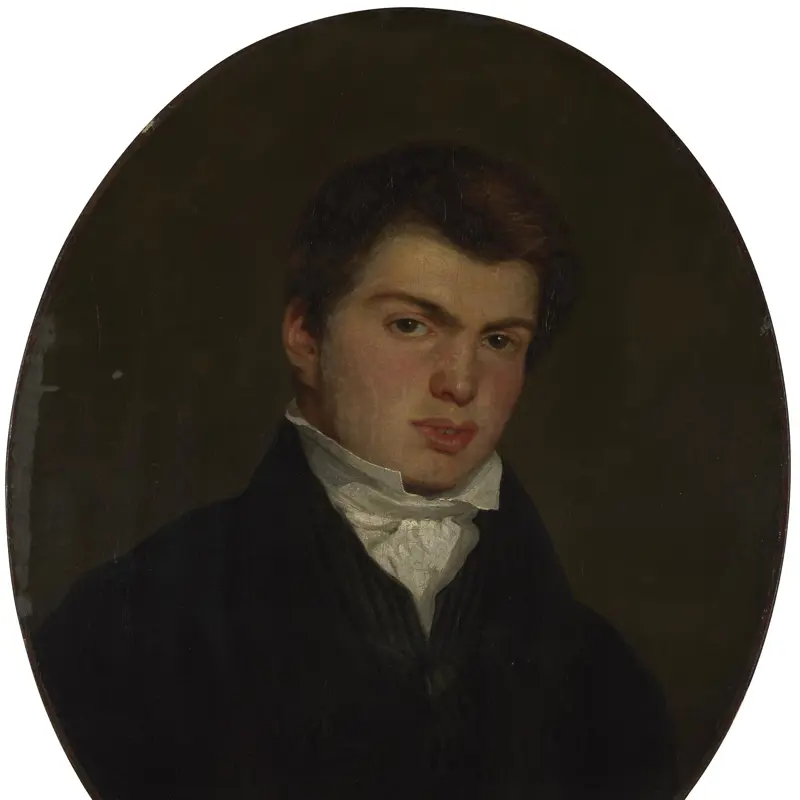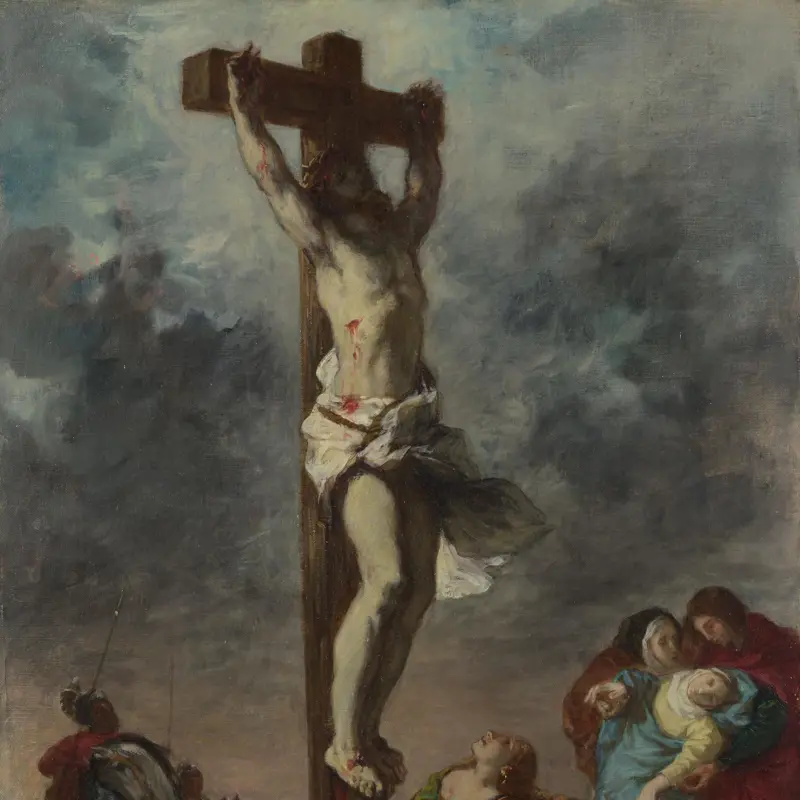Eugène Delacroix, 'Ovid among the Scythians', 1859
About the work
Overview
In AD 8 the Roman poet Ovid, author of the poem Metamorphoses, was banished for life by the Emperor Augustus to the port of Tomis on the coast of the Black Sea. At that time, this region was inhabited by the Scythians, nomadic warrior-tribes who originally came from the area now known as southern Siberia. Delacroix depicts the kindness shown to Ovid, wearing a blue toga, by a group of Scythians, who offer him food and milk, while others look on. In keeping with the classical subject, the balanced distribution of figures across the painting echoes the structure of a Roman frieze and also recalls the landscapes of seventeenth-century French artists such as Claude (1604/5–1682) and Nicolas Poussin (1594–1665).
Key facts
Details
- Full title
- Ovid among the Scythians
- Artist
- Eugène Delacroix
- Artist dates
- 1798 - 1863
- Date made
- 1859
- Medium and support
- Oil on canvas
- Dimensions
- 87.6 × 130.2 cm
- Inscription summary
- Signed; Dated
- Acquisition credit
- Bought, 1956
- Inventory number
- NG6262
- Location
- Not on display
- Collection
- Main Collection
- Frame
- 19th-century French Frame
Provenance
Additional information
Text extracted from the ‘Provenance’ section of the catalogue entry in Martin Davies, with additions and some revisions by Cecil Gould, ‘National Gallery Catalogues: French School: Early 19th Century, Impressionists, Post-Impressionists, etc.’, London 1970 and supplemented by Isobel Muir; for further information, see the full catalogue entry.
Exhibition history
-
2011Delacriox (1798-1863)CaixaForum Madrid18 October 2011 - 15 January 2012CaixaForum Barcelona15 February 2012 - 20 May 2012
-
2015Delacroix and the Rise of Modern ArtMinneapolis Institute of Art18 October 2015 - 10 January 2016The National Gallery (London)17 February 2016 - 22 May 2016
-
2018DelacroixMusée du Louvre26 March 2018 - 23 July 2018The Metropolitan Museum of Art12 September 2018 - 6 January 2019
-
2019In the Studio: Creation at WorkMusée Delacroix15 May 2019 - 30 September 2019
-
2022Fruits of the Spirit: Art from the HeartThe National Gallery (London)November 2022 - 9999
Bibliography
-
1859Z. Astruc, Les 14 stations du Salon 1859, Paris 1859
-
1859M. Aubert, Souvenirs du Salon de 1859, Paris 1859
-
1859L. Auvray, Salon de 1859, Paris 1859
-
1859M. du Camp, Le Salon de 1859, Paris 1859
-
1859A. Dumas, L'art et les artistes contemporains au Salon de 1859, Paris 1859
-
1859H. Dumesnil, Le Salon de 1859, Paris 1859
-
1859H. Fouquier, Études artistiques: Lettres sur le Salon de 1859, Marseille 1859
-
1859L. Jourdan, Les peintres français: Salon de 1859, Paris 1859
-
1859E. de Lépinois, L'art dans la rue et l'art au Salon, Paris 1859
-
1859M. Stevens, Impressions d'une femme au salon de 1859, Paris 1859
-
1859A. de Belloy, 'Salon de 1859', L'Artiste, 1859
-
1859A. Du Pays, 'Salon de 1859', L'Illustration, 1859
-
1859A. Fizelière, 'L'Exposition à vol d'oiseau', L'Artiste, 1859
-
1859V. Fournel, 'Le Salon de 1859', Le Correspondant, XLVII, 1859, pp. 157f
-
1859T. Gautier, 'Exposition de 1859', Moniteur universel, 1859
-
1859A. Houssaye, 'Eugène Delacroix', L'Artiste, 1859
-
1859A. Houssaye, 'Salon de 1859', Le Monde illustré, 1859
-
1859L. Leroy, 'Salon de 1859, VII', Le Charivari, 1859
-
1859M. Lescure, 'Le Salon de 1859', Gazette de France, 1859
-
1859P. Mantz, 'Salon Review', Gazette des beaux-arts, 1859
-
1859A. de Montaiglon, 'La peinture au Salon de 1859', Revue universelle des arts, IX/5, 1859
-
1859C. Perrier, 'Le Salon de 1859', Revue contemporaine, ser. 2, XI, 1859, pp. 287-324
-
1859J. Rousseau, 'Salon de 1859', Le Figaro, 1859
-
1859P. de Saint-Victor, 'Le Salon de 1859', La Presse, 1859
-
1859A. Tardieu, 'Le Salon de 1859', Le Constitutionnel, 1859
-
1859Chaud-de-Ton, 'Salon de 1859', La Verité contemporaine, 1859
-
1859E.-J. Delécluze, 'Exposition de 1859', Le Journal des débats, 1859
-
1865A. Piron, Eugène Delacroix, sa vie et ses oeuvres, Paris 1865
-
1873A. Moreau, E. Delacroix et son oeuvre, Paris 1873
-
1885A. Robaut and E. Chesneau, L'oeuvre complet d'eugène Delacroix, Paris 1885
-
1892L. Roger-Milès, Cent chefs-d'oevure des collections françaises et étrangères, Paris 1892
-
1916E. Moreau-Nélaton, Delacroix, raconté par lui-même, Paris 1916
-
1926R. Escholier, Delacroix: Peintre, graveur, écrivain, 3 vols, Paris 1926
-
1930L. Hourticq, Delacroix, l'oeuvre du maître, Paris 1930
-
1930Musée du Louvre, Exposition Eugène Delacroix, 2 vols, Paris 1930
-
1931L. Venturi, 'Delacroix', L'arte, 1931, pp. 73-4
-
1935A. Joubin (ed.), Correspondance générale, 5 vols, Paris 1935
-
1950A. Joubin (ed.), Journal de Eugène Delacroix, Paris 1950
-
1955C. Baudelaire, 'Salon de 1859', in The Mirror of Art, London 1955
-
1956The National Gallery, The National Gallery: January 1955 - June 1956, London 1956
-
1957Martin Davies, National Gallery Catalogues: French School, 2nd edn (revised), London 1957
-
1963R. Huyghe, Delacroix, London 1963
-
1969P. Pool, Delacroix, London 1969
-
1970Davies, Martin, and Cecil Gould, National Gallery Catalogues: French School: Early 19th Century, Impressionists, Post-Impressionists etc., London 1970
-
1971F. Trapp, The Attainment of Delacroix, Baltimore 1971
-
1979R. Jullian, 'Delacroix et le paysage', L'Oeil, 282-283, 1979
-
1981L. Johnson, The Paintings of Eugène Delacroix: A Critical Catalogue, 6 vols, Oxford 1981
-
1981M. Sérullaz, Delacroix, Paris 1981
-
1988D. Scott, Pictorialist Poetics: Poetry and the Visual Arts in Nineteenth Century France, Cambridge 1988
-
1993A. Daguerre de Hureaux, Delacroix, Paris 1993
-
1994G. Tinterow and H. Loyrette, Origins of Impressionism, (exh. cat. Metropolitan Museum of Art, 1994), New York 1994
-
1995H. Loyrette, 'Delacroix's "Ovid in Exile"', The Burlington Magazine, CXXXVII/1111, 1995, pp. 682-3
-
1996A. Dumas, Degas as a Collector, London 1996
-
1996L. Johnson, 'Letter', The Burlington Magazine, 1996
-
1996H. Loyrette, 'Letter in Reply to L. Johnson', The Burlington Magazine, CXXXVIII/1117, 1996
-
1997A. Dumas et al., The Private Collection of Edgar Degas (exh. cat. Metropolitan Museum of Art, 1 October 1997 - 11 January 1998), New York 1997
-
1998Grand Palais, Delacroix: Les dernières années (exh. cat., Galeries nationales du Grand Palais, 7 April 1998 - 20 July 1998; Philadelphia Museum of Art, 10 September 1998 - 3 January 1999), Paris 1998
-
2001
C. Baker and T. Henry, The National Gallery: Complete Illustrated Catalogue, London 2001
-
2022S. Avery-Quash and A. Lepine (eds), Fruits of the Spirit: Art from the Heart, London 2022
About this record
If you know more about this work or have spotted an error, please contact us. Please note that exhibition histories are listed from 2009 onwards. Bibliographies may not be complete; more comprehensive information is available in the National Gallery Library.



